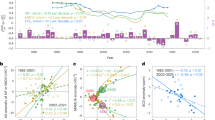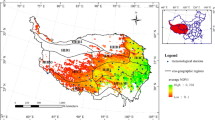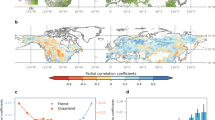Abstract
Spring greening has been widely observed across the Northern Hemisphere (NH) using a remotely sensed vegetation index (e.g., the normalized difference vegetation index, NDVI). However, there is still a debate on the ecological effects of spring greening on seasonal carbon and water budgets. This study jointly investigated the concurrent and lagged effects of spring greening on carbon gain (gross primary productivity, GPP) and water loss (evapotranspiration, ET) in the summer-active ecosystems at mid and high latitudes of NH using remote sensing and multimodel ensemble data during 1982–2013. The results showed that the collective promotion of spring greening to concurrent GPP and ET is widespread despite variations in magnitude and significance. Both beneficial and adverse lagged effects of spring greening on summer GPP commonly appear with an obvious spatial heterogeneity and difference among climate-plant types. However, the expected significant suppression of spring greening to summer GPP was rarely observed even in the areas where spring ET was significantly promoted by spring greening. Nevertheless, when drought was taken into account, the response patterns of spring water use to spring greening varied to some extent, and the adverse lagged effect of spring greening to summer GPP appeared or strengthened in some regions, especially during the years with dry summer. Given the predicted warming of the climate and more frequent climatic extremes, the adverse effect of spring greening should be given more attention.






Similar content being viewed by others
References
Beck HE, Zimmermann NE, McVicar TR, Vergopolan N, Berg A, Wood EF (2018) Present and future Köppen-Geiger climate classification maps at 1-km resolution. Sci Data 5:180214. https://doi.org/10.1038/sdata.2018.214
Buermann W, Bikash PR, Jung M, Burn DH, Reichstein M (2013) Earlier springs decrease peak summer productivity in north American boreal forests. Environ Res Lett 8:24027. https://doi.org/10.1088/1748-9326/8/2/024027
Buermann W, Forkel M, O’Sullivan M, Sitch S, Friedlingstein P, Haverd V, Jain AK, Kato E, Kautz M, Lienert S, Lombardozzi D, Nabel JEMS, Tian H, Wiltshire AJ, Zhu D, Smith WK, Richardson AD (2018) Widespread seasonal compensation effects of spring warming on northern plant productivity. Nature 562:110–115. https://doi.org/10.1038/s41586-018-0555-7
Chen J, Jönsson P, Tamura M, Gu Z, Matsushita B, Eklundh L (2004) A simple method for reconstructing a high-quality NDVI time-series data set based on the Savitzky–Golay filter. Remote Sens Environ 91:332–344. https://doi.org/10.1016/j.rse.2004.03.014
Chen S, Zhang L, Liu X, Guo M, She D (2018) The use of SPEI and TVDI to assess temporal-spatial variations in drought conditions in the middle and lower reaches of the Yangtze River basin, China. Adv Meteorol 2018:9362041. https://doi.org/10.1155/2018/9362041
Cheng L, Zhang L, Wang Y et al (2017) Recent increases in terrestrial carbon uptake at little cost to the water cycle. Nat Commun 8:1–10. https://doi.org/10.1038/s41467-017-00114-5
Dai J, Fdez-Arroyabe P, Sheridan DC (2019) Foreword for IJB special issue on Asian biometeorology. Int J Biometeorol 63:563–568. https://doi.org/10.1007/s00484-019-01725-x
Del Grosso SJ, Parton WJ, Derner JD, Chen M, Tucker CJ (2018) Simple models to predict grassland ecosystem C exchange and actual evapotranspiration using NDVI and environmental variables. Agric For Meteorol 249:1–10. https://doi.org/10.1016/j.agrformet.2017.11.007
ESA: Land Cover CCI Product User Guide Version 2.0, available at: http://maps.elie.ucl.ac.be/CCI/viewer/download/ESACCI-LC-Ph2-PUGv2_2.0.pdf, last access: 10 Nov 2017
Flanagan LB, Syed KH (2011) Stimulation of both photosynthesis and respiration in response to warmer and drier conditions in a boreal peatland ecosystem. Glob Chang Biol 17:2271–2287. https://doi.org/10.1111/j.1365-2486.2010.02378.x
Forzieri G, Alkama R, Miralles DG, Cescatti A (2017) Satellites reveal contrasting responses of regional climate to the widespread greening of earth. Science 356:1180–1184. https://doi.org/10.1126/science.aal1727
Helman D, Lensky IM, Yakir D, Osem Y (2017) Forests growing under dry conditions have higher hydrological resilience to drought than do more humid forests. Glob Chang Biol 23:2801–2817. https://doi.org/10.1111/gcb.13551
Hetherington AM, Woodward FI (2003) The role of stomata in sensing and driving environmental change. Nature 424:901–908. https://doi.org/10.1038/nature01843
Hu J, Moore DJP, Burns SP, Monson RK (2010) Longer growing seasons lead to less carbon sequestration by a subalpine forest. Glob Chang Biol 16:771–783. https://doi.org/10.1111/j.1365-2486.2009.01967.x
Hufkens K, Friedl MA, Keenan TF et al (2012) Ecological impacts of a widespread frost event following early spring leaf-out. Glob Chang Biol 18:2365–2377. https://doi.org/10.1111/j.1365-2486.2012.02712.x
Ji Y, Jin J, Zhu Q et al (2020) Unbalanced forest displacement across the coastal urban groups of eastern China in recent decades. Sci Total Rnviron 705:135900. https://doi.org/10.1016/j.scitotenv.2019.135900
Jin J, Wang Y, Zhang Z, Magliulo V, Jiang H, Cheng M (2017) Phenology plays an important role in the regulation of terrestrial ecosystem water-use efficiency in the northern hemisphere. Remote Sens 9:664. https://doi.org/10.3390/rs9070664
Jung M, Reichstein M, Schwalm CR, Huntingford C, Sitch S, Ahlström A, Arneth A, Camps-Valls G, Ciais P, Friedlingstein P, Gans F, Ichii K, Jain AK, Kato E, Papale D, Poulter B, Raduly B, Rödenbeck C, Tramontana G, Viovy N, Wang YP, Weber U, Zaehle S, Zeng N (2017) Compensatory water effects link yearly global land CO2 sink changes to temperature. Nature 541:516–520. https://doi.org/10.1038/nature20780
Jung M, Koirala S, Weber U, Ichii K, Gans F, Camps-Valls G, Papale D, Schwalm C, Tramontana G, Reichstein M (2019) The FLUXCOM ensemble of global land-atmosphere energy fluxes. Sci Data 6:74. https://doi.org/10.1038/s41597-019-0076-8
Keenan TF, Hollinger DY, Bohrer G, Dragoni D, Munger JW, Schmid HP, Richardson AD (2013) Increase in forest water-use efficiency as atmospheric carbon dioxide concentrations rise. Nature 499:324–327. https://doi.org/10.1038/nature12291
Keenan TF, Gray J, Friedl MA et al (2014) Net carbon uptake has increased through warming-induced changes in temperate forest phenology. Nat Clim Chang 4:598–604. https://doi.org/10.1038/nclimate2253
Lasslop G, Reichstein M, Papale D et al (2010) Separation of net ecosystem exchange into assimilation and respiration using a light response curve approach: critical issues and global evaluation. Glob Chang Biol 16:187. https://doi.org/10.1111/j.1365-2486.2009.02041.x
Liu Y, Xiao J, Ju W, Xu K, Zhou Y, Zhao Y (2016) Recent trends in vegetation greenness in China significantly altered annual evapotranspiration and water yield. Environ Res Lett 11:94010. https://doi.org/10.1088/1748-9326/11/9/094010
Martens B, Miralles DG, Lievens H et al (2017) GLEAM v3: satellite-based land evaporation and root-zone soil moisture. Geosci Model Dev 10:1903–1925. https://doi.org/10.5194/gmd-10-1903-2017
Melillo JM, Steudler PA, Aber JD, Newkirk K, Lux H, Bowles FP, Catricala C, Magill A, Ahrens T, Morrisseau S (2002) Soil warming and carbon-cycle feedbacks to the climate system. Science 298(5601):2173–2176. https://doi.org/10.1126/science.1074153
Miralles DG, Holmes TRH, de Jeu RAM, Gash JH, Meesters AGCA, Dolman AJ (2011) Global land-surface evaporation estimated from satellite-based observations. Hydrol Earth Syst Sci 15:453–469. https://doi.org/10.5194/hess-15-453-2011
Nelson JA, Carvalhais N, Migliavacca M, Reichstein M, Jung M (2018) Water stress induced breakdown of carbon-water relations: indicators from diurnal FLUXNET patterns. Biogeosciences 15:2433–2447. https://doi.org/10.5194/bg-2017-152
Novick KA, Ficklin DL, Stoy PC et al (2016) The increasing importance of atmospheric demand for ecosystem water and carbon fluxes. Nat Clim Chang 6:1023–1027. https://doi.org/10.1038/nclimate3114
Piao S, Yin G, Tan J, Cheng L, Huang M, Li Y, Liu R, Mao J, Myneni RB, Peng S, Poulter B, Shi X, Xiao Z, Zeng N, Zeng Z, Wang Y (2015) Detection and attribution of vegetation greening trend in China over the last 30 years. Glob Chang Biol 21:1601–1609. https://doi.org/10.1111/gcb.12795
Reichstein M, Falge E, Baldocchi D et al (2005) On the separation of net ecosystem exchange into assimilation and ecosystem respiration: review and improved algorithm. Glob Chang Biol 11:1424–1439. https://doi.org/10.1111/j.1365-2486.2005.001002.x
Richardson AD, Keenan TF, Migliavacca M, Ryu Y, Sonnentag O, Toomey M (2013) Climate change, phenology, and phenological control of vegetation feedbacks to the climate system. Agric For Meteorol 169:156–173. https://doi.org/10.1016/j.agrformet.2012.09.012
Richardson AD, Hufkens K, Milliman T, Aubrecht DM, Furze ME, Seyednasrollah B, Krassovski MB, Latimer JM, Nettles WR, Heiderman RR, Warren JM, Hanson PJ (2018) Ecosystem warming extends vegetation activity but heightens vulnerability to cold temperatures. Nature 560:368–371. https://doi.org/10.1038/s41586-018-0399-1
Rollinson CR, Kaye MW (2012) Experimental warming alters spring phenology of certain plant functional groups in an early successional forest community. Glob Chang Biol 18:1108–1116. https://doi.org/10.1111/j.1365-2486.2011.02612.x
Seddon AWR, Macias-Fauria M, Long PR, Benz D, Willis KJ (2016) Sensitivity of global terrestrial ecosystems to climate variability. Nature 531:229–232. https://doi.org/10.1038/nature16986
Sévellec F, Drijfhout SS (2018) A novel probabilistic forecast system predicting anomalously warm 2018-2022 reinforcing the long-term global warming trend. Nat Commun 9:1–12. https://doi.org/10.1038/s41467-018-05442-8
Shen M, Piao S, Jeong S, Zhou L, Zeng Z, Ciais P, Chen D, Huang M, Jin CS, Li LZ, Li Y, Myneni RB, Yang K, Zhang G, Zhang Y, Yao T (2015) Evaporative cooling over the tibetan plateau induced by vegetation growth. PNAS 112:9299–9304. https://doi.org/10.1073/pnas.1504418112
Sippel S, Zscheischler J, Reichstein M (2016) Ecosystem impacts of climate extremes crucially depend on the timing. PNAS 113:5768–5770. https://doi.org/10.1073/pnas.1605667113
Sippel S, Forkel M, Rammig A et al (2017) Contrasting and interacting changes in simulated spring and summer carbon cycle extremes in european ecosystems. Environ Res Lett 12:75006. https://doi.org/10.1088/1748-9326/aa7398
Spinoni J, Naumann G, Vogt JV (2017) Pan-European seasonal trends and recent changes of drought frequency and severity. Glob Planet Chang 148:113–130. https://doi.org/10.1016/j.gloplacha.2016.11.013
Teuling AJ, Seneviratne SI, Stöckli R et al (2010) Contrasting response of european forest and grassland energy exchange to heatwaves. Nat Geosci 3:722–727. https://doi.org/10.1038/ngeo950
Tramontana G, Jung M, Schwalm CR et al (2016) Predicting carbon dioxide and energy fluxes across global FLUXNET sites with regression algorithms. Biogeosciences 13:4291–4313. https://doi.org/10.5194/bg-13-4291-2016
Tucker CJ, Fung IY, Keeling CD, Gammon RH (1986) Relationship between atmospheric CO2 variations and a satellite-derived vegetation index. Nature 319:195–199. https://doi.org/10.1038/319195a0
Tucker CJ, Pinzon JE, Brown ME et al (2005) An extended AVHRR 8-km NDVI dataset compatible with MODIS and SPOT vegetation NDVI data. Int J Remote Sens 26:4485–4498. https://doi.org/10.1080/01431160500168686
Vicente-Serrano SM, Beguería S, López-Moreno JI (2010) A multiscalar drought index sensitive to global warming: the standardized precipitation evapotranspiration index. J Clim 23:1696–1718. https://doi.org/10.1175/2009JCLI2909.1
Vicente-Serrano SM, Gouveia C, Camarero JJ, Beguería S, Trigo R, López-Moreno JI, Azorín-Molina C, Pasho E, Lorenzo-Lacruz J, Revuelto J, Morán-Tejeda E, Sanchez-Lorenzo A (2013) Response of vegetation to drought time-scales across global land biomes. PNAS 110:52–57. https://doi.org/10.1073/pnas.1207068110
von Buttlar J, Zscheischler J, Rammig A et al (2018) Impacts of droughts and extreme-temperature events on gross primary production and ecosystem respiration: a systematic assessment across ecosystems and climate zones. Biogeosciences 15:1293–1318. https://doi.org/10.5194/bg-15-1293-2018
Wang Y, Liu Y, Jin J (2018) Contrast effects of vegetation cover change on evapotranspiration during a revegetation period in the Poyang lake basin, China. Forests 9:217. https://doi.org/10.3390/f9040217
Wellstein C, Poschlod P, Gohlke A, Chelli S, Campetella G, Rosbakh S, Canullo R, Kreyling J, Jentsch A, Beierkuhnlein C (2017) Effects of extreme drought on specific leaf area of grassland species: a meta-analysis of experimental studies in temperate and sub-Mediterranean systems. Glob Chang Biol 23:2473–2481. https://doi.org/10.1111/gcb.13662
Wu J, Albert LP, Lopes AP, Restrepo-Coupe N, Hayek M, Wiedemann KT, Guan K, Stark SC, Christoffersen B, Prohaska N, Tavares JV, Marostica S, Kobayashi H, Ferreira ML, Campos KS, da Silva R, Brando PM, Dye DG, Huxman TE, Huete AR, Nelson BW, Saleska SR (2016) Leaf development and demography explain photosynthetic seasonality in amazon evergreen forests. Science 351:972–976. https://doi.org/10.1126/science.aad5068
Yun J, Jeong S, Ho C, Park C, Park H, Kim J (2018) Influence of winter precipitation on spring phenology in boreal forests. Glob Chang Biol 24:5176–5187. https://doi.org/10.1111/gcb.14414
Zeng Z, Piao S, Li LZX et al (2018) Impact of earth greening on the terrestrial water cycle. J Clim 31:2633–2650. https://doi.org/10.1175/JCLI-D-17-0236.1
Zhu Z, Piao S, Myneni RB et al (2016) Greening of the earth and its drivers. Nat Clim Chang 6:791–795. https://doi.org/10.1038/nclimate3004
Acknowledgments
Data used are available at https://www.bgc-jena.mpg.de/geodb/projects/DataDnld.php (FLUXCOM GPP), https://www.gleam.eu/#4 (GLEAM v3.3a ET), https://ecocast.arc.nasa.gov/data/pub/gimms/3g.v1/ (GIMMS 3 g.v1 NDVI), http://maps.elie.ucl.ac.be/CCI/viewer/download.php (ESA CCI LC maps), http://www.gloh2o.org/koppen/ (Köppen-Geiger climate classification maps), http://digital.csic.es/handle/10261/128892 (SPEI).
Funding
This work was supported by the National Natural Science Foundation of China [grant numbers 41971374 and 41807173] and the Fundamental Research Funds for the Central Universities (grant number B200202016).
Author information
Authors and Affiliations
Corresponding author
Additional information
Publisher’s note
Springer Nature remains neutral with regard to jurisdictional claims in published maps and institutional affiliations.
Rights and permissions
About this article
Cite this article
Jin, J., Guo, F., Sippel, S. et al. Concurrent and lagged effects of spring greening on seasonal carbon gain and water loss across the Northern Hemisphere. Int J Biometeorol 64, 1343–1354 (2020). https://doi.org/10.1007/s00484-020-01913-0
Received:
Revised:
Accepted:
Published:
Issue Date:
DOI: https://doi.org/10.1007/s00484-020-01913-0




